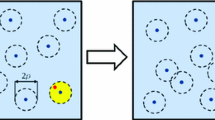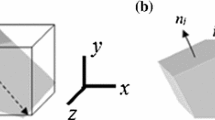Abstract
Discrete element methods are emerging as useful numerical analysis tools for engineers concerned with granular materials such as soil, food grains, or pharmaceutical powders. Obviously, the first step in a discrete element simulation is the generation of the geometry of the system of interest. The system geometry is defined by the boundary conditions as well as the shape characteristics (including size) and initial coordinates of the particles in the system. While a variety of specimen generation methods for particulate materials have been developed, there is no uniform agreement on the optimum specimen generation approach. This paper proposes a new triangulation based approach that can easily be implemented in two or three dimensions. The concept of this approach (in two dimensions) is to triangulate a system of points within the domain of interest, creating a mesh of triangles. Then the particles are inserted as the incircles of these triangles. Extension to three dimensions using a mesh of tetrahedra and inserting the inspheres is relatively trivial. The major advantages of this approach include the relative simplicity of the algorithm and the small computational cost associated with the preparation of an initial particle assembly. The sensitivity of the characteristics of the particulate material that is generated to the topology of the triangular mesh used is explored. The approach is compared with other currently used methods in both two and three dimensions. These comparisons indicate that while this approach can successfully generate relatively dense two-dimensional particle assemblies, the three- dimensional implementation is less effective at generating dense systems than other available approaches.
Similar content being viewed by others
References
K. Bagi, ‘‘Some typical examples of tessellation for granular materials’’, In: Introduction to mechanics of granular materials, M. Oda, A. A. Balkema and K. Iwashita (Eds.), (Rotterdam, The Netherlands, 1999), p. 2–5
K. Bagi, ‘‘From order to chaos: The mechanical behavior of regular and irregular assemblies’’, Proceedings QuaDPM’03 Workshop, K. Bagi (Ed.), (BUTE Budapest, 2003), p. 33–42
C. B. Barber, D. P. Dobkin & H. T. Huhdanpaa, ‘‘The Quickhull Algorithm for Convex Hulls’’, ACM Transactions on Math. Softw. 22(4) (1996), p. 469–483
D. Boutt & B. McPherson, ‘‘The role of particle packing in modeling rock mechanical behavior using discrete elements’’, In: B. K. Cook and R. P. Jensen, (Eds.), Discrete Element Methods, 3rd international conference, (ASCE, New Mexico 23-25 September, 2002), p. 86–92
B. Cambou, ‘‘Micromechanical approach in granular mechanics’’, In: B. Cambou (Ed.), Behaviour of granular materials, Number 385 in CISM Courses and Lectures, (Wien-New York, Springer-Verlag, 1998)
B. Cambou, M. Chaze & F. Dedecker, ‘‘Change of scale in granular materials’’, Eur. J. Mechanics, A (Solids) 19 (2000), p. 999–1014
Y. T. Feng, K. Han & D. R. J. Owen, ‘‘Filling domains with disks: An advancing front approach, Inter. J. Numer. Methods in Engineering 56(5) (2003), p. 699–731
J.-A. Ferrez, Dynamic Triangulations for Efficient 3-D simulation of Granular Materials, Ph. D. thesis, (Ecole Polytechnique Federal de Lausanne, Lausanne, 2001)
J. D. Goddard, ‘‘Delaunay Triangulation of Granular Media’’, In: Bicanic, N. (Ed.) Proceedings of ICADD-4, Fourth International Conference on Analysis of Discontinuous Deformation, Glasgow 6th -8th, University of Glasgow, June 2001, p. 281–292
Itasca, PFC2D 2.00 Particle Flow Code in Two Dimensions, Minneapolis Minnesota, 1998
W. S. Jodrey & E. M. Tory, ‘‘Computer simulation of close random packing of equal spheres’’, Phys. Rev. A 32(4) (1985), p. 2347–2351
B. Joe, Geompack++. ZCS Inc., Calgary, AB, Canada, 2003, (www.allstream.net/∼bjoe/index.htm)
X. Lin & T.-T. Ng, A three-dimensional discrete element model using arrays of ellipsoids. Geotechnique 47(2) (1997), p. 319–329
A. Liu & B. Joe, Relationship between tetrahedron shape measures. BIT 34 (1994), p. 268–287
D. L. Marcum, ‘‘Unstructured Grid Generation Using Automatic Point Insertion and Local Reconnection’’, In: Thompson, J. F, Soni, B. K. and Weatherill, N. P. (Eds.), Handbook of Grid Generation, (CRC Press, 1999), p. 18-1–18-31
C. O’Sullivan, The Application of Discrete Element Modelling to Finite Deformation Problems in Geomechanics, Ph. D. thesis, University of California, Berkeley , 2002
C. O’Sullivan, J. D. Bray & M. F. Riemer, ‘‘Influence of Particle Shape and Surface Friction Variability on Response of Rod-Shaped Particulate Media’’, ASCE J. Engineering Mechanics 128(11) (2002), p. 1182–1192
C. O’Sullivan, J. D. Bray & S. Li, ‘‘A New Approach for Calculating Strain for Particulate Media’’, Inter. J. Numer. Anal. Methods in Geomechanics 27(10), (2003), p. 859–877
C. O’Sullivan, J. D. Bray & M. F. Riemer, ‘‘3-D DEM Validation using Steel Balls with Regular Packing Arrangements’’, Proceedings of the Third International Conference on Discrete Element Methods: Numerical Modelling of Discontinua, ASCE Geotechnical Special Publication No. 117 (2002), p. 217–221
H. Sakaguchi & A. Murakami, Initial packing in discrete element modeling. In: B. K. Cook and R. P. Jensen (Eds.), Discrete Element Methods, 3rd international conference, (ASCE, New Mexico 23-25 September, 2002), p. 104– 106
J. R. Shewchuk, Triangle: A Two-Dimensional Quality Mesh Generator and Delaunay Triangulator. (Version 1.4)Computer Science Division. (University of California at Berkeley, 2002) (http://www-2.cs.cmu.edu/∼quake/ triangle.html)
J. R. Shewchuk, ‘‘Triangle: Engineering a 2D Quality Mesh Generator and Delaunay Triangulator’’, First Workshop on Applied Computational Geometry (Philadelphia, Pennsylvania), ACM, May 1996, p. 124–133
The MathWorks, Inc. (1994-2003) MATLAB (http:// www.mathworks.com/products/matlab)
P. Thomas, Discontinuous deformation analysis of particulate media, Ph. D. thesis, (Univ. of California, Berkeley, 1997)
C. Thornton, ‘‘Three-dimensional behavior of granular materials’’, In: M. Oda and K. Iwashita (Eds.), Introduction to mechanics of granular materials, Chapter 3.3.5, A.A. Balkema, 1999 p. 187–196
Author information
Authors and Affiliations
Corresponding author
Additional information
The research presented in this paper made use of software developed by other researchers. For the two-dimensional study the program Triangle developed by Jonathan Shewchuk was used. The three-dimensional analysis used the Geompack++ program developed by Barry Joe as well as an implementation of the Jodrey and Tory (1985) algorithm by Monika Bargiel and Jacek Moscinski called NSCP3D.
Rights and permissions
About this article
Cite this article
Cui, L., O’Sullivan, C. Analysis of a triangulation based approach for specimen generation for discrete element simulations. GM 5, 135–145 (2003). https://doi.org/10.1007/s10035-003-0145-7
Received:
Issue Date:
DOI: https://doi.org/10.1007/s10035-003-0145-7




